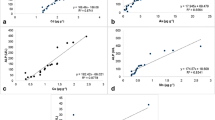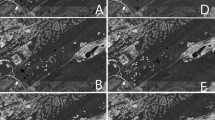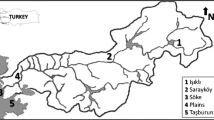Abstract
The Eastern box turtle (Terrapene carolina carolina) is a primarily terrestrial chelonian distributed across the eastern US. It has been proposed as a biomonitor due to its longevity, small home range, and reliance on the environment to meet its metabolic needs. Plasma samples from 273 free-ranging box turtles from populations in Tennessee and Illinois in 2011 and 2012 were evaluated for presence of heavy metals and to characterize hematologic variables. Lead (Pb), arsenic (As), zinc (Zn), chromium (Cr), selenium (Se), and copper (Cu) were detected, while cadmium (Cd) and silver (Ag) were not. There were no differences in any metal detected among age class or sex. However, Cr and Pb were higher in turtles from Tennessee, while As, Zn, Se, and Cu were higher in turtles from Illinois. Seasonal differences in metal concentrations were observed for Cr, Zn, and As. Health of turtles was assessed using hematologic variables. Packed cell volume was positively correlated with Cu, Se, and Pb in Tennessee. Total solids, a measure of plasma proteins, in Tennessee turtles were positively correlated with Cu and Zn. White blood cell count, a measure of inflammation, in Tennessee turtles was negatively correlated with Cu and As, and positively correlated with Pb. Metals are a threat to human health and the health of an ecosystem, and the Eastern Box Turtle can serve as a monitor of these contaminants. Differences established in this study can serve as baseline for future studies of these or related populations.


Similar content being viewed by others
References
Allender MC (2012) Characterizing the epidemiology of Ranavirus in North American chelonians: diagnosis, surveillance, pathogenesis, and Therapy. PhD Dissertation, University of Illinois
Beresford WA, Donovan MP, Henninger JM, Waalkes MP (1981) Lead in the bone and soft tissues of box turtles caught near smelters. Bull Environ Contam Toxicol 27:349–352
Borkowski R (1997) Lead poisoning and intestinal perforations in a snapping turtle (Chelydra serpentine) due to fishing gear ingestion. J Zoo Wildl Med 28:109–113
Burger J, Carruth-Hinchey C, Ondroff J, McMahon M, Gibbons JW, Gochfeld M (1998) Effects of lead on behavior, growth, and survival of hatchling slider turtles. J Toxicol Environm Health Part A 55:495–502
Burger J, Jeitner C, Schneider L, Vogt R, Gochfeld M (2010) Arsenic, cadmium, chromium, lead, mercury, and selenium levels in blood of four species on turtles from the Amazon in Brazil. J Toxicol Environ Health Part A 73:33–40
Burnham KP, Anderson DR (1998) Model selection and inference: a practical information-theoretic approach. Springer, New York
Chaffin K, Norton TM, Gilardi K, Poppenga R, Jensen JB, Moler P, Cray C, Dierenfeld ES, Chen T, Oliva M, Origgi FC, Gibbs S, Mazarro L, Mazet J (2008) Health assessment of free-ranging alligator snapping turtles (Macrochelys temminickii) in Georgia and Florida. J Wildl Dis 44:670–686
Davidson C (2004) Declining downwind: amphibian population declines in California and historical pesticide use. Ecol Appl 14:1892–1902
Dodd CK (2001) North American box turtles: a natural history. University of Oklahoma Press, Norman
Fitzgerald K, Vera R (2006) Reported toxicities in reptiles. In: Mader D (ed) Reptile Medicine and Surgery. Elsevier Publishing, St. Louis, pp 1068–1080
Friend M, Franson JC (1999) Lead. In: Ciganovich (ed) Field manual of wildlife diseases. USGS Biology Resources Division, Washington, pp 317–334
Gibbons JW, Scott DE, Ryan TJ, Buhlmann KA, Tuberville TD, Metts BS, Greene JL, Mills T, Leiden Y, Poppy S, Winne CT (2000) The global decline of reptiles, Deja Vu Amphibians. Bioscience 50:653–666
Golden NH, Rattner BA (2003) Ranking terrestrial vertebrate species for utility in biomonitoring and vulnerability to environmental contaminants. Rev Environ Contam Toxicol 176:67–136
Grillitsch B, Schiesari L (2010) The ecotoxicology of metals in reptiles. In: Sparling D, Linder G, Bishop CA, Krest SK (eds) Ecotoxicology of Amphibians and Reptiles, 2nd edn. CRC Press, Boca Raton, pp 337–448
Guthrie RK, Cherry DS (1979) Trophic level accumulation of heavy metals in a coal ash basin drainage system. Water Res Bull 25:244–248
Harmata AR, Restani M (2013) Lead, mercury, selenium, and other trace elements in tissues of golden eagles from southwestern Montanta, USA. J Wildl Dis 49:114–124
Hays KA, McBee K (2010) Population demographics of red-eared slider turtles (Trachemys scripta) from the Tar Creek superfund site. J Herpetol 44:441–446
Hopkins WA, Mendonca MT, Rowe CL, Congdon JD (1998) Elevated trace element concentrations in southern toads, Bufo terrestris, exposed to coal combustion waste. Arch Environ Contam Toxicol 35:325–329
Jacobson ER, Gaskin JM, Brown MB, Harris RK, Gardiner CH, LaPointe JL, Adams HP, Reggiardo C (1991) Chronic upper respiratory tract disease of free-ranging desert tortoises (Xerobates agassizii). J Wildl Dis 27:296–316
Ley-Quinonez C, Zavala-Norzagaray AA, Espinosa-Carreon TL, Peckham H, Marquez-Herrera C, Campos-Villegas L, Aguirre AA (2011) Baseline heavy metals and metalloid values in blood of loggerhead turtles (Caretta caretta) from Baja California Sur, Mexico. Mar Pollut Bull 62:1979–1983
Martinez-Lopez E, Sousa AR, Maria-Mojica P, Gomez-Ramirez P, Guilhermino L, Garcia-Fernandez AJ (2010) Blood δ-ALAD, lead, and cadmium concentrations in spur-thighed tortoises (Testudo graeca) from southeastern Spain and northern Africa. Ecotoxicology 19:670–677
Pellalo-Martinez NA, Ilizaliturri-Hernandez CA, Espinosa-Reyes G, Carrizales-Yanez L, Gonzalez-Mille DJ (2011) Assessment of exposure to lead in humans and turtles living in an industrial site in Coatzacoalcos Veracruz, Mexico. Bull Environ Contam Toxicol 86:642–645
Rocke TE, Samuel MD (1991) Effects of lead shot ingestion on selected cells of the mallard immune system. J Wildl Dis 27:1–9
Rose BMR, Allender MC (2011) Health assessment of wild Eastern box turtles (Terrapene carolina carolina) in East Tennessee. J Herpetol Med Surg 21:107–112
Rowe CL, Kinney OM, Fiori AP, Congdon JD (1996) Oral deformities in tadpoles (Rana catesbeiana) associated with coal ash deposition: effects on grazing ability and growth. Freshw Biol 36:723–730
Sleeman J (2008) Use of wildlife rehabilitation centers as monitors of ecosystem health. In: Fowler ME, Miller RE (eds) Zoo and wild animal medicine, current therapy 6. Saunders Elsevier, St. Louis, pp 97–104
Smith PN, Cobb GP, Godard-Codding C, Hoff D, McMurry ST, Rainwater TR, Reynolds KD (2007) Contaminant exposure in terrestrial vertebrates. Environ Poll 150:41–64
Sparling DW, Fellers GM, McConnell LL (2001) Pesticides and amphibian population declines in California, USA. Environ Toxicol Chem 20:1591–1595
Van Dijk PP (2011) Terrapene carolina. IUCN red list of threatened species. IUCN, Cambridge
Yu S, Halbrook RS, Sparling DW, Colombo R (2011) Metal accumulation and evaluation of effects in a freshwater turtle. Ecotoxicology 20:1801–1812
Yu S, Halbrook RS, Sparling DW (2013) Correlation between heavy metals and turtle abundance in ponds near the Paducah gaseous diffusion plant, Kentucky USA. Arch Environ Contam Toxicol 65:555–566
Acknowledgments
The authors would like to thank students of CRESO and University of Illinois College of Veterinary Medicine for assistance with sample collection and Gerald Bargren and Yakov Lavorsky of the Illinois Sustainable Technology Center for assistance with chemical analysis.
Conflict of interest
The authors declare that they have no conflict of interest.
Statement of Human and Animal Rights
All applicable international, national, and/or institutional guidelines for the care and use of animals were followed. All procedures performed in studies involving animals were in accordance with the ethical standards of the institution or practice at which the studies were conducted. This article does not contain any studies with human participants performed by any of the authors.
Informed Consent
There were no human subjects, thus informed consent is not applicable for this study.
Author information
Authors and Affiliations
Corresponding author
Rights and permissions
About this article
Cite this article
Allender, M.C., Dreslik, M.J., Patel, B. et al. Select metal and metalloid surveillance of free-ranging Eastern box turtles from Illinois and Tennessee (Terrapene carolina carolina). Ecotoxicology 24, 1269–1278 (2015). https://doi.org/10.1007/s10646-015-1498-5
Accepted:
Published:
Issue Date:
DOI: https://doi.org/10.1007/s10646-015-1498-5




